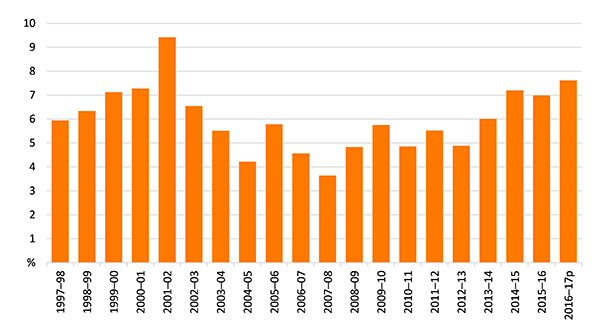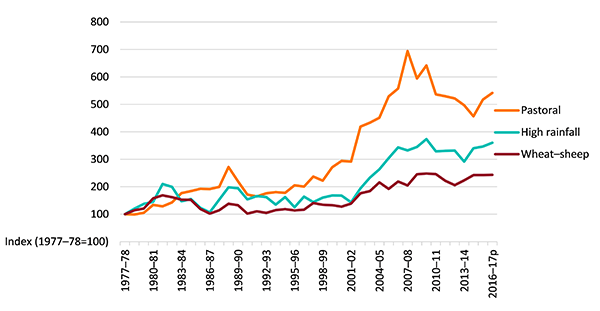Peter Martin, Caroline Levantis, Walter Shafron, Paul Philips and James Frilay
Farm investment
A producer’s capacity to generate farm income is influenced by past investments in additional land to expand the scale of farming activities, and in new infrastructure, plant and machinery to boost productivity in the longer term.
Over the decade to 2016–17 broadacre and dairy farmers invested heavily in land, plant and machinery. In 2016–17 new investment remained relatively high for broadacre and dairy farms.
In 2014–15 and 2015–16 higher average farm cash income for broadacre farms led to an increased proportion of broadacre farmers acquiring additional land through purchase or lease (Figure 1). Around 8 per cent of broadacre farms acquired additional land in both 2014–15 in 2015–16. This was above the average of 5 per cent for the previous 10 years and comparable with the rates of the late 1990s and early 2000s. In 2016–17 an estimated 7.6 per cent of broadacre farms acquired additional land.
percentage of farms

p ABARES preliminary estimate.
Source: ABARES Australian Agricultural and Grazing Industries Survey
Between 2009–10 and 2013–14 land values reported for broadacre and dairy farms declined in some regions, particularly in the pastoral zone of northern Australia (Figure 2). From 2014–15 to 2016–17 increased land sales led to a slight increase in reported broadacre land values in some regions. This was particularly the case in high rainfall regions and some pastoral zone regions.
average per farm

p ABARES preliminary estimate.
Source: ABARES Australian Agricultural and Grazing Industries Survey
Data and other resources
Broadacre and dairy industries data
AgSurf provides a large selection of ABARES farm survey data on the broadacre and dairy industries.
Beef, lamb and sheep industries data
A large selection of ABARES farm survey data on the beef, slaughter lambs and sheep industries.
Farm surveys definitions and methods
Further information about our survey definitions and methods.
Previous reports
See our publications page for previous versions of the report Australian farms surveys results.
About my region
ABARES has produced a series of individual profiles of the agricultural, forestry and fisheries industries in your region. Each regional profile presents an overview of the agriculture, fisheries and forestry sectors in the region, and the recent financial performance of the broadacre and, where relevant, dairy, vegetable, and sugarcane industries.
